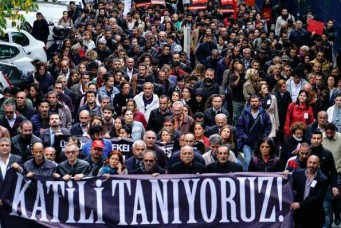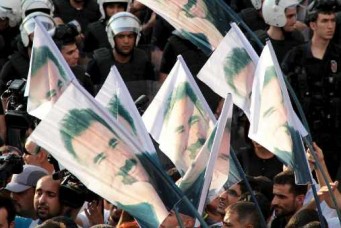State, Media, and Political Messaging in Contemporary Turkey
The AKP’s political messaging tactics have undergone significant change over time, but remain an important strategic tool for the party.
Communication Strategies in Turkey: Erdoğan, the AKP and Political Messaging. By Taner Dogan, 2020, 240 pp.
Research on political communication is a burgeoning field, preoccupied primarily with the roles played by media in political systems; especially the transmission of information between political agents and stakeholders, state, media, and the wider public, which shapes global politics today. Equipped with refreshing empirical material based on an extensive understanding of political communication literature as well as theories on branding and Americanization, Taner Doğan’s recent book, Communication Strategies in Turkey: Erdoğan, the AKP and Political Messaging, undertakes a timely cross-sectional analysis of Turkish president Erdoğan’s and the AKP’s (Justice and Development Party, 2002-present) political communication practices in the last two decades.
The book scrutinizes how Erdoğan and his political party have used political communication in favour of Erdoğan’s populist Islamist ideology to transform the image of Muslims and religious conservatives in Turkey and abroad, as well as building a legacy that provides the foundation for a ‘New Turkey’. The book is a valuable contribution to existing studies in global political communication, examining the crucial case study of Turkey at a time when the AKP government has attempted a regime change.
With a nuanced analysis, the book captures changes in the AKP’s political communication over time. The book benefits from a diversity of empirical material, from Erdoğan’s political rallies to election campaigns, in order to account for the style of as well as the transformation in his political communication strategies.
In Chapter 2, Doğan reviews the existing literature on political communication and political public relations focusing on the Americanization of political communication; particularly personalization, image-making, and charisma. The third chapter scrutinizes the historical development of modern Turkey from the Ottoman Empire to the current rise of political Islam. While the book has evidently benefited from Doğan’s deep knowledge of the intellectual heritage of political Islam in Turkey, it fast-forwards other movements and intellectual heritages in Turkey, such as the status quoist Kemalist tradition and the Kurdish identity and resistance against the establishment.
The book fails in this part to situate its arguments on political communication in Turkey by referring to any media scholars’ work on different aspects of political communication during the AKP regime, such as Erkan Saka, Bilge Yeşil, Mine Genel Bek, Murat Akser, just to name a few. The lack of engagement with critical studies on the media capture and censorship of the AKP governments over the years leads to inevitable omissions in the analysis of political communication of the AKP governments.
Although the book mentions that the AKP government controls 85 percent of mainstream media in Turkey, it fails to discuss the closing down of alternative newspapers and media platforms through governmental decrees and the government’s subsequent designation of these outlets and their employees as ‘terrorists’. The book also does not mention how the public broadcaster Turkish Radio and Television Corporation (TRT) has become the ultimate political tool of the regime. It is surprising that a book on political communication patterns and strategies of the AKP government only mentions TRT once and in a positive light, to show how the AKP enabled minority rights for Kurds during the peace process through the introduction of TRT Kurdi.
In the fourth chapter, Doğan examines the AKP’s code of identity by highlighting the relevance of Erdoğan’s personality as the main asset of AKP’s self-branding. In the fifth chapter, the author identifies religion as a critical component of AKP’s political communication and points to how ‘one-to-one communication’ is Erdoğan’s preferred communication pattern in addressing supporters at outdoor rallies. In the same chapter, Doğan also covers Erdoğan’s shifting fashion and style over the years, which is an original addition and methodological perspective to conventional studies in political communication. Doğan observes that while the wearing of an “almond moustache” (badem bıyık) has permanently marked the image of Erdoğan and other party members, Erdoğan has also tweaked his style to meet the demands of perceived political change. For example, Doğan shows how Erdoğan started to wear green ties after the Gezi Park protests.
In addition to the use of more traditional techniques such as communication with gestures, Doğan throws extensive light on some of the most unique communication patterns by Erdoğan, such as his reciting of poems in order to appeal to his supporters and the wider public. The book also showcases the strategic and pragmatic digital communication strategies of Erdoğan and the AKP. For example, Doğan accounts for how the AKP party members use ‘up-to-date’ techniques and tools such as selfies and Instagram to reach the members of generation Z, while mentioning more repressive techniques used by the government such as political trolls, who are paid Internet trolls that advance certain political ideologies, agendas and topics in favor of political organizations and/or governments.
Chapter 6 analyses Erdoğan’s speeches from 2002 to 2019 to discuss the evolution of political messaging in terms of human rights, freedom of speech, anti-establishment discourse, and cultural dialogue. Chapter 7 presents a perspective of Erdoğan’s communication through an analysis of Doğan’s interviews, ethnographic observations, and Erdoğan’s speeches. The last chapter is an attempt at predicting the future of post-Erdoğan Turkey by summarizing opportunities and challenges for the ruling AKP. This issue is addressed through a discussion of how the AKP is currently facing an identity crisis regarding secularism versus conservatism and individualism versus collectivism.
The book presents a thorough conceptualization of the Americanization and personalisation of political communication by situating the communicative strategies of the AKP. Yet it is not entirely apparent how theories on social movements have helped the author make his claims on political Islam and political communication of the AKP. Furthermore, the short note at the beginning of the book introduces readers to the qualitative and quantitative research methods used throughout the book. This note reveals that Doğan examined the evolution of the AKP’s communication strategies through non-participant observations, in-depth and informal interviews, and quantitative content analysis.
The book posits the ‘I’ of the author all throughout, from Doğan’s witnessing of various political events and campaigns, to his interviews with high ranking AKP members; but the readers do not gain a sense of how these interviews were conducted and how Doğan’s non-participant observation was feasible amongst this political circle. The methodology does not reveal how Doğan was able to gain access to the headquarters of the AKP and the VIP lounges where he interviewed high profile government members such as Erdoğan’s senior advisors.
Overall, the book embraces a critical perspective of Erdoğan’s regime, and especially of the second part of the AKP’s reign in Turkey, by showcasing the vast political powers Erdoğan has acquired after taking possession of the judiciary, military and the police from 2009 onwards. However, it also ascribes to the liberal myth of ‘positive developments’ and ‘polyphonic voices’ in the early days of the AKP government in the 2000s. Indeed, in its early days, the AKP received a carte blanche from both national and international liberals and mainstream intellectuals, leading the way to its authoritarian turn in the 2010s.
Nonetheless, despite these shortcomings, the book throws a dynamic light on how the AKP uses public relations and political messaging opportunities to influence their target audience. Doğan’s work then makes a valuable contribution to the study of global political communication, which is an otherwise Western-centric field.
Özge Özdüzen is a lecturer in sociology and communications at Brunel University London. She has published numerous journal articles on media and politics in Turkey and is currently a principal investigator for a European Commission Horizon 2020 project. On Twitter: @ozgeozdu
Read More




